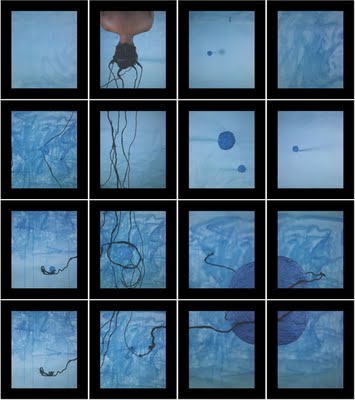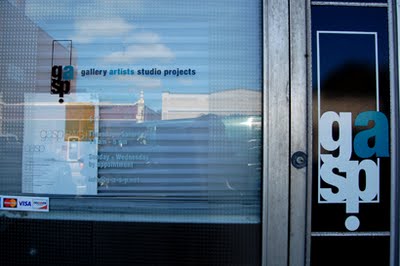Maria Magdalena Campos-Pons interview

I interviewed Brookline artist Maria Magdalena Campos-Pons at GASP Gallery in Brookline, which she runs with her husband Neil Leonard, on Oct. 8, 2009. We spoke about the gallery, about the state of art in Boston, and about her proposal for a Boston drawing biennale. Below are some excerpts:
- “You see a lot of art from Europe in the city [Boston], but you don’t see a significant amount of art that is coming out of the South. And I am interested in that. I don’t want to be: you go to Venice, you see the art in Venice, and then you bring it to Boston. You go to New York, you see the art in Gagosian [Gallery] and then you bring it to Boston. Actually, we are a little more outside the predictable. We want to think about these are a group of interesting artists, let’s bring it to Boston. They don’t need to be approved by the Venice Biennale, they don’t need to be approved by Gagosian or whatever it is. … That’s what we are interested in. Art exists in a realm that is not just in the official stamp by the institutions that establish value. And that’s what we are. And that’s what we care for. So Liliana Angulo is an extraordinary photographer and we brought here. She’s a Columbian. I mentioned her name, I could mention other names.”
- “When I’m thinking of GASP, I’m thinking of word of mouth. What are artists thinking that is interesting? Not just what the establishment of the curator class is thinking is exciting. Because we ask artists to propose ideas. So they are thinking this has a value. We want to show that. We want to see that. We’re putting attention to that. Some museums are doing that now. … It’s a very different dynamic. We have curiosity about that. We don’t have any anti position about what other institutions are doing.”
- “I didn’t start a gallery. I started a project. I don’t consider GASP a gallery. I consider GASP an artistic and civic project. This is not only a space to express ideas artistically but it is a space to engage civically, socially. So I see that as a commitment as a citizen to a stamp of values and ideas that I believe are important. So I see that as a parallel.”
- “I was challenged by the [Brookline] neighborhood, by the locality. I was thinking what an interesting spot to have art, and why is there no art there. I would have done GASP in any part of Boston, wherever I be. I have been thinking that I want to do something in Boston for a long time. I wanted to see a dynamic of things in a different way. I don’t think that I like to criticize subjects. I like to act on things. So rather than say: This is not working. I want to say: Let me do something.”

- “The model of curatorial work is so old, it’s so 20th century, and it’s post-19th century in a way. It’s so elitist. It’s so centered in the opinion of the few chosen. And I refuse to accept that. And I hope that I’m not going to make all the curators now my enemy and I’m going to be right out of everything. I benefit from that and I respect the structure and the rationality beyond that. But I think we are in a moment where things could be richer, more open because of the time that we live in and the way that we live. And I want GASP to be that. I want GASP to be in that kind of milieu, more opportunities to think and to come and to be.”
- “In my belief some of the best work that people ever produce they produce in the later years of school. And that’s true for me too. After that a lot of limitations are placed. Cindy Sherman made her ‘Stills’ when she was still in school. Ana Mendieta, some of the most spectacular work that she produced, she did in the University of Iowa.”
- “I live in Boston. I’m not intending to move. Maybe I should. But I’m not planning to do that. I love Boston. Always when I’m abroad, when I am outside I talk a lot about Boston. I think that it is an interesting city. I think that it is a city that challenges you intellectually. I think that it is a city of knowledge. If you were going to talk in 19th century terms, it would be like illuminated. And I think that it’s a city that could benefit from having people like me. I am not so Bostonian. I am not so engaged with the scene that made Boston, that Boston is. And in some way, maybe this is selfish, I think that I refresh Boston in a way. The kind of energy that I have. Boston is more self-contained, less exuberant. And I think that I was looking for a little bit of exuberance, a little bit of unpredictability to it. But I love the freshness of Boston. It’s a young city always. And the reason that it is always young is that it is a city of students. And I think that that gives Boston such a rapport. It’s a city in which you need to keep yourself alert. If you want to be effective here, you need to be thinking and you need to be an active thinker. Otherwise, everything passes by because people are on the move. People don’t come here to stay. They come here to pass by, acquire something and then go.”
- “People say that Boston is a quiet city, that nothing happens here. But, really, if you are engaged with what happens in this city you don’t have free time. I cannot keep track of what happens, I cannot follow what I want to follow in the city. I don’t have the physical time or hours to see or participate in everything that’s happening in the city that I want to be part of. Period.”
- “Maybe what I like about Boston, what challenges me about Boston, is what I’m not. Boston is a city that offers a lot of resistance to a new-comer, a lot of resistance to break through. But the beauty is that and yet this is a city that opens up. And yet this is a city that is exciting if you look for it. I go to Paris and to London and to New York and Dakar, everywhere, Tokyo, and I’m still coming back and thinking it’s interesting to be here. It’s not that dour. I am in New York and I come back and I say here is different, but in the differing there is some beauty there. All that I do is when I’m bored, I just take a plane and leave. [she quips:] And that’s often.”
- A subcommittee of the Mass. Creative Economy Council recently asked: Is Massachusetts sexy? Their answer is no, it’s conservative. “I think that this is not a true portrait of Boston. I think that intelligence is sexy. Knowledge is sexy. Curiosity is sexy. Research is sexy. And that is Boston. I don’t find frivolity sexy. I don’t. So it depends what you look at.”
- “What is missing here is the sense of a togetherness as a city. You think in New York they take so much pride in being a New Yorker. We need something like the Red Sox cheerleaders. So much pride about being an artist living in Boston because we have this institution and this institution and they’re all doing fabulous stuff.”
- “I travel a lot. Maybe the other thing is I see a lot of things outside Boston. So maybe I don’t see what is missing because I fill myself with so many other things out there that I balance that.”

- For at least a couple years now Campos-Pons has mulled the idea of founding a Boston Drawing Biennale. “I have been thinking for a long time, in all my traveling, in all the cities that I have been in the First World and in the Third World, what could be a moment of currencies, what could be the thing that joins together and then brings this city together with force in the visual arts? When I curated that show of drawing [at the Boston Center for the Arts], I saw so many drawings, so many works done by many artists, and drawing came as an interesting territory to explore. And I have been working with a little task force just to try to define if we do that what it could be and when it could be. We have been talking for a long time in terms of biennale. … Maybe it doesn’t need to be an biennale. Maybe it could be some sort of different kind of format. I don’t want to call it a festival. What we have done now is just to pass to a different number of people just a little write out to see if this idea is valuable. The idea is to bring together all these institutions. To bring together the forces that are separated between the Harvard Museum, the Museum of Fine Arts, the ICA, MIT, Isabella, all the colleges, and find the way that the entire city becomes a force with some kind of umbilical cord – the umbilical cord could be drawing – and really make Boston a destination. And seriously we could bring people together for that and see what kind of response. At this moment it’s just a big conversation still. But a serious conversation. I just want to be sure that it happens. I want to keep talking. I don’t want any other road except the road that it happens.”
- “I don’t know maybe it is the Boston Drawing Editions. I was thinking it’s a commitment. When you say a biennale you commit yourself to every two years to create something that requires a lot of infrastructure. However the idea for this project is just that. The idea is people coming in mass to Boston to see this project. We gain tourism. We get visibility. We get everything. We’re thinking that we could do it. All the talking here that I have been passing this idea, everybody says excellent, brilliant. The question is, I know in Boston to lift something out of the ground you need to push. But I hope that we will manage to do it and it is something that will happen in one format or another. It could start in one institution. It could be one institution is the mothership to start it. And that year’s edition is in that institution. And the next, two years, three years, edition is in another institution.”
- “I don’t think Boston has yet become a destination. People don’t come to Boston from elsewhere. … We want to be a destination. I would like to be part of something that people say can’t miss it, you need to be there. … I think it hasn’t yet gotten that punch in which people say we need to come this week to be in Boston because there is going to be this body of work that we absolutely can’t miss. So we need to talk. I hope that a lot of people will be at the table.”







0 Comments:
Post a Comment
<< Home